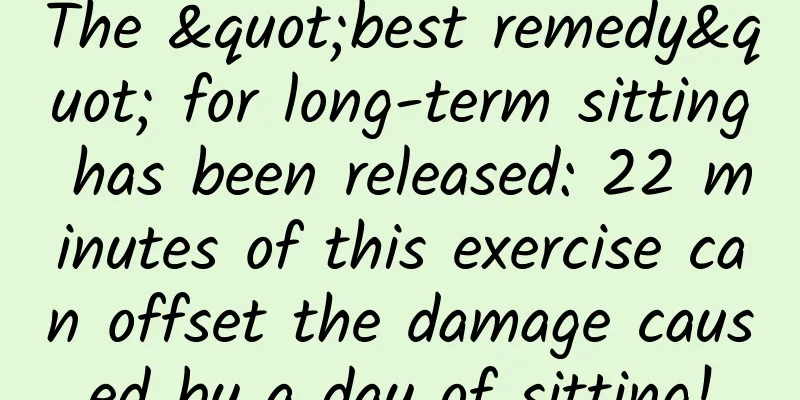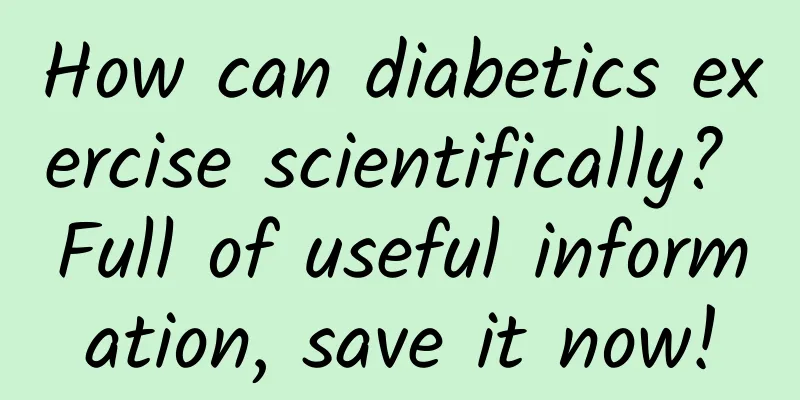The "best remedy" for long-term sitting has been released: 22 minutes of this exercise can offset the damage caused by a day of sitting!

|
Sitting for a long time has become a normal part of many people's work and life. They take the bus when going out, sit in front of the computer all day long in the office, attend meetings, and lie down when they get home... However, prolonged sitting is associated with a variety of diseases and an increased risk of death. Regular sitting can lead to obesity, cervical spondylosis, constipation, high blood pressure, diabetes, cancer, etc. However, many people sit for long periods of time every day because of work needs or because they have to sit for long periods of time. So how can we reduce the harm of sitting for long periods of time? Health Times The best remedy for long-term sitting is 22 minutes of this kind of exercise every day Recently, the British Journal of Sports Medicine published a study that found that people who sit for more than 12 hours a day can offset the increased risk of death by doing 22 minutes or more of "moderate to high intensity exercise" per day compared to 8 hours! And no matter how long you sit, as long as you move, it is associated with a lower risk of death. This can be said to be the best remedy for sitting for too long! The study included about 12,000 people and found that regardless of the length of time spent sitting, more "moderate to high intensity exercise" can reduce the risk of death. If "moderate to high intensity exercise" is ≥ 22 minutes, there is no significant difference in the risk of death between people who sit for 8 hours a day and those who sit for 12 hours a day. This means that at least 22 minutes of moderate to high intensity physical activity a day can offset the increased risk of death from sitting for a long time. ① This can be said to be the "best remedy" for people who sit for long periods of time to reduce the risk of death. Which exercises are considered “moderate to high intensity exercises”? According to the World Health Organization, adults should do 300 minutes of moderate-intensity aerobic exercise per week, or more than 150 minutes of high-intensity aerobic exercise; or a combination of equal amounts of moderate-intensity and vigorous-intensity exercise, which is better for health! How to judge mild, moderate and high-intensity exercise? The World Health Organization once published an article explaining that mild physical activity refers to activities such as slow walking that do not significantly increase our heart rate, breathing rate, etc., while moderate and high-intensity physical activities will bring about significant changes in heart rate. 1. Low-intensity exercise. During low-intensity exercise, the heart rate is maintained at about 100 beats per minute, and the body feels slightly warm. For example, walking, walking the dog, doing housework, etc. are all low-intensity exercises. 2. Moderate-intensity exercise. Moderate-intensity exercise means that the heart rate is 100 to 140 beats per minute. During the exercise, you can feel sweating, your breathing is relatively rapid, and you feel a little strenuous. For example: brisk walking, jogging, cycling, swimming, yoga , etc. 3. High-intensity exercise. High-intensity exercise means that the heart rate is greater than 140 beats per minute. At this time, you will sweat profusely, your heart rate will be violent, you will be panting, and you will feel out of breath. For example: fast running, high-speed cycling, fast high leg raises, squats and jumping jacks, HIIT (high-intensity interval training), etc. How to increase the amount of “medium to high intensity” exercise every day? Many people are very busy every day. How can they increase their daily “medium to high intensity” exercise? 1. Climb stairs In daily work and life, many people are used to taking the elevator. It is recommended that you adjust your habit of taking the elevator to go upstairs and change to climbing stairs. Climbing stairs is a medium-to-high intensity training. If you have to climb more than ten flights of stairs every day when you go to work and go home, you can greatly increase the amount of "medium-to-high intensity" exercise every day. 2. Walk fast If the commute is short (within 5 kilometers), it is recommended that you replace the car with a brisk walk. When walking, you can pay attention to your heart rate and pace. A speed of 130 to 140 steps per minute is preferred, and your heart rate should be controlled within the medium-intensity exercise range of 100 to 140 beats per minute. 3. Cycling If your commute is a little far (5-10 kilometers), you can try fast cycling. Fast cycling is also a medium to high intensity exercise that can effectively exercise our largest muscle group - the thigh muscles. Remember these 4 points before medium-to-high-intensity exercise 1. Warm up thoroughly before exercise Be sure to warm up thoroughly before exercise to avoid sports injuries. Stretch and relax your muscles after exercise. If you have recently felt unwell, have a cold, fever, chest pain, difficulty breathing, dizziness, headache, joint discomfort, etc., avoid medium to high intensity exercise. 2. Take it step by step when exercising Exercise should be done gradually and within one's ability. Don't be too eager to exercise. Especially for those who don't usually exercise, it is best not to do sudden and intense exercise, which is easy to cause sports injuries. Especially for those who are obese or have joint diseases, they should be wary of excessive exercise that may cause damage to the body. 3. Stop if you feel uncomfortable during exercise If you feel uncomfortable during exercise, stop immediately. "Sport-related sudden death is more likely to occur when exercising after an injury, illness, poor health, overwork, lack of sleep, or a cold or fever." Hu Xitian, chief physician of the Fourth Department of Cardiovascular Medicine at Shijiazhuang First Hospital, reminded in an interview with Hebei News Network in 2016 that if you are very tired recently, it is best to reduce strenuous exercise. Once you feel chest tightness, lack of oxygen, dizziness, or radiating pain in the back, you should stop exercising immediately and go to the hospital for examination. ③ 4. Cool down after exercise The sudden stop after strenuous exercise is equivalent to "brake emergency", so you need to do a "cool down exercise" after exercise. Liu Peizhong, deputy chief physician of the Department of Cardiology at Zhuhai Hospital of Guangdong Provincial Hospital of Traditional Chinese Medicine, published an article in Health Times in 2019, saying that cool down exercises can slow down the rapid heartbeat to a safe level; accelerate the excretion of metabolic products such as lactic acid, relax muscles, eliminate fatigue as soon as possible, promote physical recovery, and reduce muscle soreness after exercise. ④ Jogging, brisk walking, stretching and relaxation after moderate to high intensity exercise can maintain and promote blood circulation. In the cool-down exercise, gradually slow down the movements and reduce the heart rate to below 120 beats/minute, which generally takes 5 to 10 minutes. Health Times 5. Don’t drink too much after exercise After exercise, many people feel dry mouth and want to drink a lot of water quickly. At this time, it is recommended to calm the body first, drink water in small sips multiple times, and do not drink in large gulps. Tao Ling, director of the Department of Cardiology at the Second People's Hospital of Lanzhou City, Gansu Province, said in an interview with Runliu News in 2022, "Because water accumulates in the gastrointestinal tract in a short period of time, in addition to feeling heavy and bloated in the stomach, it will also affect the activity of the diaphragm, and then affect normal breathing. A large amount of water entering the blood will also rapidly increase blood volume, suddenly increase the burden on the heart, and lead to abnormal cardiopulmonary function."⑤ This article is compiled from: ②2021-04-20 World Health Organization "Exercise is also divided into high, medium and low intensity? Do you understand the WHO's recommendations? " ③2016-03-03 Hebei News Network "Why does exercise kill people? -- Experts reveal the truth about sudden death during exercise" ④2019-03-15 Health Times "Do a "Cool-Down Exercise" After Exercise" ⑤2022-10-10 Benliu News "Does high-intensity exercise increase the risk of sudden death? Listen to the doctor's advice" Source: Health Times |
<<: Is premature ejaculation caused by "kidney deficiency"? The answer is...
>>: Fatty liver is not exclusive to fat people, malnourished and thin people can also get it!
Recommend
Should I lie flat or on my side during labor contractions?
For women who are about to give birth, the pain a...
Why do the leaves of Amaryllis always turn yellow? How to remedy the yellowing of Amaryllis leaves?
Amaryllis is a common flower in China. It is love...
Why is two hours of outdoor exercise every day helpful in preventing and controlling myopia?
Natural light: The light intensity in the outdoor...
Why do pregnant women have nipples?
Many women will experience nipple pain after chil...
Is follicle 20x17 the dominant follicle?
Under normal circumstances, a group of follicles ...
Will a small cervix affect sex life? How to deal with it?
A small cervix is a problem experienced by many...
How many days is normal for abdominal pain after miscarriage
In modern society, the probability of unwanted pr...
Subvert your cognition! To prevent Alzheimer's disease, you may only need one shot of vaccine? !
As the aging process of the population accelerate...
Can I get pregnant if I have enteritis?
Some women suffer from enteritis themselves, but ...
Symptoms and dangers of antenatal depression
Female friends also experience many changes durin...
Is it dangerous to be angry after a miscarriage?
No matter when, depression has a great impact on ...
Female stars' hip twisting and twisting set off a trend of imitating, doctors warn: there is a risk of injury →
Recently, an artist's "hip twisting"...
When are pine nuts picked? What are the nutritional values of pine nuts?
Pine nuts are the seeds of pine trees. They conta...
What to do if you catch a cold during the confinement period
What should you do if you catch a cold during the...








![[Health Lecture] Do you know what happens after you decide to have IVF?](/upload/images/67f13e8eac67d.webp)
